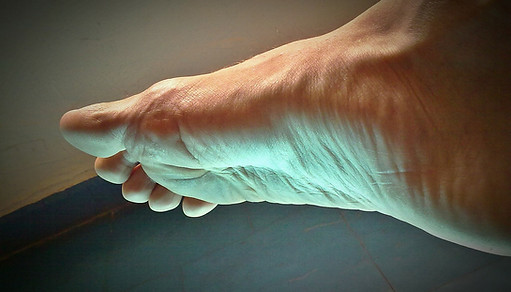Daniel Lewis Podiatry
Kingston Beach Health Centre
2 Recreation Street
Kingston Beach TAS 7050
Tel: (03) 62 299 844
Plantar Warts

Plantar Warts by David Webby
Plantar Warts, also known as Verrucae, are caused by the Verrucae Virus.
The Virus gets into the cells of the epidermis layer of the skin, via a break in the skin. Viruses survive in moist environments, so that why it is common to pick up warts from swimming room change rooms, gyms, and other similar sites.
When the virus gets into the base cells of the epidermis, they cause the cells to multiply rapidly, resulting in a strange looking lesion that doesn’t have time to produce keratin, the protein which gives our skin its waterproof and smooth nature.
Plantar Warts, are called as such because they are found on the plantar surface, (under the foot), of the foot. With pressure of the body’s weight, the warty lesion is pushed into the deeper layers of the dermis layer of the skin where the nerves and blood vessels are found.
Quite often blood vessels and nerves are incorporated into the warty tissue. This is why they are so painful or have blood spots in the lesion.
Often warts get confused with corns, and vice versa, so it is important to get a proper diagnosis.
What are the differences?
- Corns form over bony prominences where there is friction or pressure, whilst Warts can form anywhere.
- Corns are usually only painful with direct pressure, whilst Warts can be painful with squeezing rather than direct pressure.
- Corns are generally a yellow colour depending on the depth, whilst Warts usually have a strange appearance with a non even border.
How can a podiatrist help?
Often a proper diagnosis is required to determine whether you have a wart or a corn. A Podiatrists use Silver nitrate to check for protein in the lesion to determine this.
After diagnosis, a Podiatrist would trim away the excess skin/warty tissue and apply an acid to create a blister. This is combined with padding to relieve pressure and make the wart more comfortable.
Acid treatments can take a long period of time, as the warty tissue is allowed to be removed without creating scar tissue.
A wart paint from the chemist may also be recommended for home application.
Take care when using wart paints as they use acid to soften the skin, but in some cases, may cause burning and blistering of the skin, which may ulcerate and become infected.
It is this reason that wart paints are not recommended for use by people who have Diabetes or poor circulation.
If you have a wart or are not sure if it is a corn or a wart, make an appointment with one of our Podiatrists for a diagnosis and treatment plan.